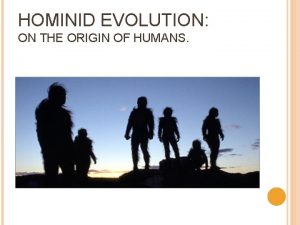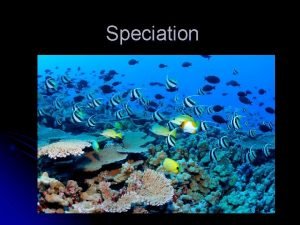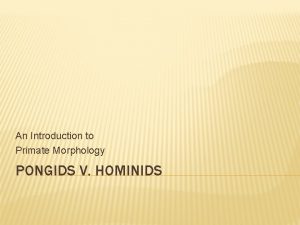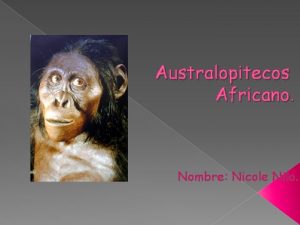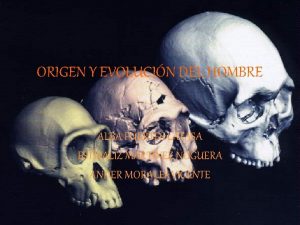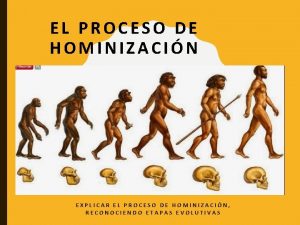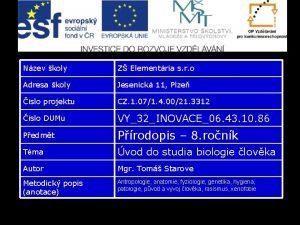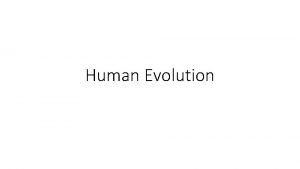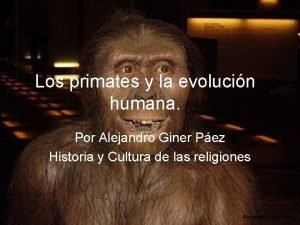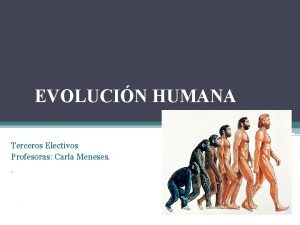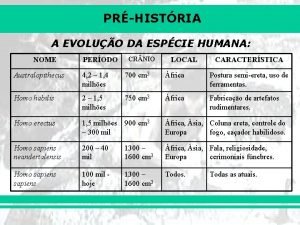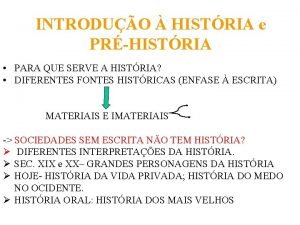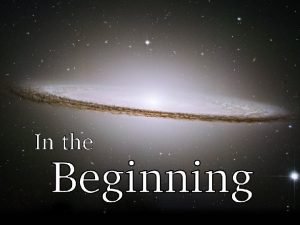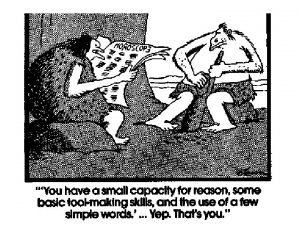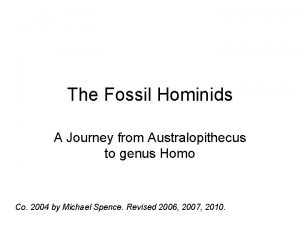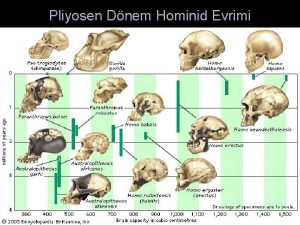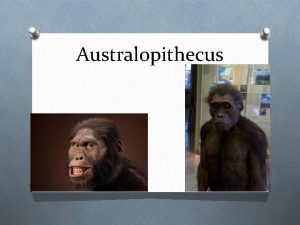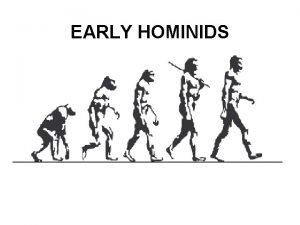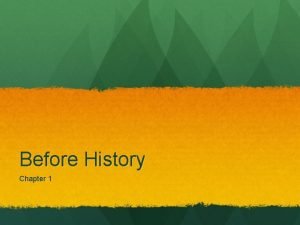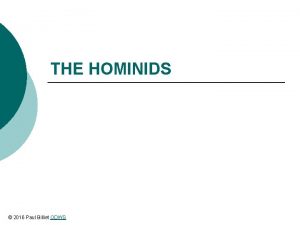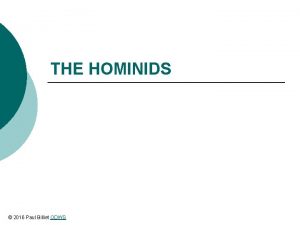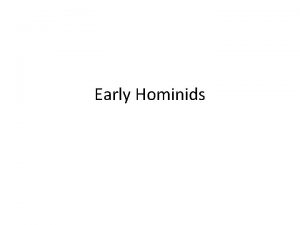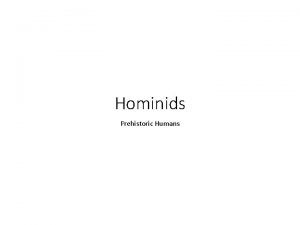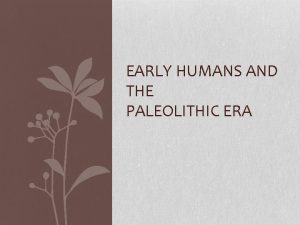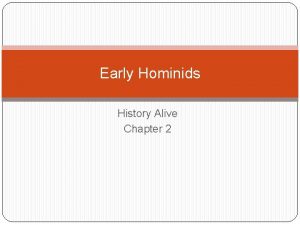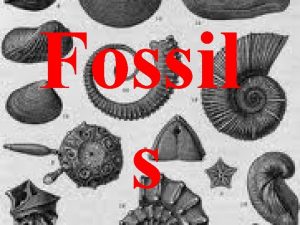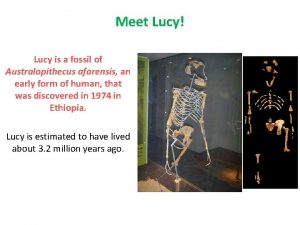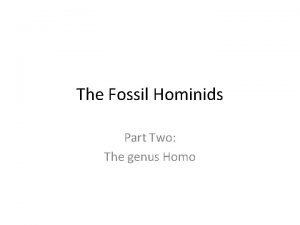The Fossil Hominids A Journey from Australopithecus to

































- Slides: 33

The Fossil Hominids A Journey from Australopithecus to genus Homo Co. 2004 by Michael Spence. Revised 2006, 2007, 2010, 2012, 2014.

Part One: The Australopithecines

Piltdown Man **FRAUD** • “Discovered” in 1912 by Charles Dawson in Sussex, England • Combination of… • Medieval human skull • Sawed-down orangutan jaw • An elephant molar • A hippopotamus tooth • A canine tooth from a Third from left standing is Charles chimpanzee fossil Dawson, wowing his colleagues in 1915. By 1953, the secret was out—FRAUD!

AUSTRALOPITHECUS – Word means “southern ape” due to its discovery in South Africa – All australopithecines were BIPEDAL – Though each species is unique, they all share the following characteristics: small cranium, prognathism, large premolars and molars, small body size, and the possibility of being arboreal.

Australopithecus ramidus • A. k. a. Ardipithecus ramidus b/c it’s too “ape-like” to be an australopithecine. • Oldest, most primitive hominid so far (4. 5 – 4. 2 mya). • Found 1994, in Awash Region in Afar (Aramis, Ethiopia). • Largest canines of any hominid yet discovered— linked with the hominids due to the lack of a gap between the canine and the premolar on lower jaw like great apes.

Ardi predates Lucy by over a million years (4. 4 mya) as the oldest link to humans. However, note the opposable big toe, large hands, and prognathic face, and ape-like pelvic region and legs indicating the species was not entirely bipedal.

Australopithecus anamensis • Found by Meave Leakey (pictured) and Alan Walker 1994, Lake Turkana, Kenya. • 4. 1 – 3. 9 mya. • Paltry fossil record: ten teeth (unrelated), leg, arm, skull parts, jaw parts. • Resembles a chimp; ramidus teeth (large canines). • Leg bones suggest more upright and human-style walking. • Arm bones suggest arboreal.


Australopithecus afarensis • First discovered in Hadar in the Afar Region, Ethiopia by Donald Johanson in 1974. • He named the discovery ‘Lucy’ after the Beatles’ song “Lucy in the Sky With Diamonds. ” She dates to approx. 3. 2 mya. • Afarensis accounts for most of the early hominid fossils found and dates from 4 – 3 mya. • Smaller, yet pronounced canines and broad incisors resemble chimp. • Definitely not arboreal, based on weight projections; but they probably were good climbers. • More pronounced prognathism. • Brain case larger, but cranium has chimp features (broad at base). • Think fully erect, 3. 5 – 5 foot tall bipedal chimp.


Donald Johanson • Schurz alum! • Graduated University of Chicago, 1974, with Ph. D in Paleoanthropology • Besides Lucy, he is credited with over 20 distinct afarensis and Homo habilis finds, has published hundreds of research articles and books, and gives yearly lecture and symposium talks throughout the world • For a time, the chief rival of the Leakey family: Richard Leakey and Johanson are bitter enemies who refuse to debate one another’s finds! • Established the Institute of Human Origins in the 1980 s which is now centered at ASU • Website: “Becoming Human”


This afarensis is the earliest known juvenile skeleton of a hominid yet found (3. 3 mya) Discovered in Hadar, Ethiopia in 2000 (research released 2006), not far from where Lucy was unearthed in 1974. Dubbed as “Lucy’s Little Sister. ” Note the prognathic features of the skull, and the incisors and canines jutting outward as in the great apes. Cranium is larger than chimps, but has its shape (again, the broad base)

Reconstructions of afarensis skulls: The “white areas” represent hypothetical projections based on the pieces found. Again note the large canines and incisors—more ape-like.

Laetoli Footprints • Discovered by Mary Leakey in Tanzania in 1975. • Dates back to 3. 6 mya—footprints of afarensis • This 75 -foot long trail resemble human feet: heel, arch, and the big toe aligned with rest of toes. • Supports that afarensis was bipedal, and perhaps fully land-based, i. e. not arboreal. • The hominids that left these prints estimate around 4 – 5 feet tall based on their stride.


Close-up of foot: Note that the big toe is aligned with the rest of the toes, a human quality. There is a pronounced heel and arch in this print based on the raised right side of the remains.

Australopithecus africanus • First australopithecine to be discovered c. 1924 by Raymond Dart. • 3. 0 – 2. 0 mya • Cranium 10% larger than afarensis. • Less prognathism. • Larger premolars and molars. Less pronounced canines. • Larger forelimbs (arms) than afarensis • Ape-like in body; human-like head.

“Taung Baby” of South Africa Found in 1924 by Raymond Dart One of the best examples of A. africanus 3 – 5 years old at death, possible eagle or hawk attack victim.

Raymond Dart (1924) with his new discovery: Australopithecus africanus, the “southern ape. ” He thought it was the skull of a baby monkey, but further testing yielded an altogether new species, as well as new science. Dart, being a pioneer in this infant field, was one of the proponents of the killer-ape-man hypothesis, which has since been discredited. The two greatest pioneers of paleoanthropology: Raymond Dart and Louis Leakey, arguing into their twilight years over yet another fossil find

Recent x-rays and other computer scans indicate that Mrs. Ples might actually be Mr. Ples. Whatever the case may be, it represents the most complete specimen of africanus yet found

Another view of Mrs. (or Mr. ) Ples. Discovered in 1947 in South Africa. It dates around 2. 8 – 2. 6 mya

The Robustine Australopithecines • • A. robustus and boisei overlap with genus homo. Dated 2. 3 – 1. 3 mya. Largest craniums of all australopithecines. “Robust” jaw bones and large teeth set them apart from rest of australopithecines. • Same size as africanus, but jaw bones and crania suggest gorilla size head. • Sometimes referred to as “Paranthropus” to distinguish from australopithecines. • Many suggest that these robustine hominids are an offshoot of africanus whose line ended, with no one as a potential descendant

Australopithecus boisei Dying out around 1. 2 mya, boisei may be the last australopithecine to become extinct.

Australopithecus aethiopicus “The Black Skull” Discovered in 1985 by Alan Walker. It is called the “Black Skull” because the soil turned the bones black during fossilization. Dated at 2. 7 – 2. 5 mya, it is the oldest robustine so far discovered and may be an ancestor to bosei and robustus

“Zinjanthropus” found by Mary Leakey and named by Louis Leakey 1959. A complete skull (the mandible has been reconstructed based on similar finds and projections This find was classified later as a boisei. Note the gorilla-like qualities of the cranium (crest), mandible (massive jaws), and the human-like teeth (large premolars and molars) which allowed them to eat hard nuts and seeds and rough plants.

Louis Leakey with a bosei jaw in one hand, a Homo habilis skull in his other, and a gorilla skull thrown in for good measure. His flamboyance, tenacity, and enthusiasm for his subject put paleoanthropology on the forefront of science. His lecture tours (which he gave up to his death) made paleoanthropology a respected field, rather than a “pseudoscience. ” He also kick-started the field of primatology by convincing and financing Jane Goodall, Dian Fossey, and Birute Galdikas to study chimpanzees, gorillas, and orangutans, respectively.

Louis Leakey: 1903 – 1972 He convinced most of the scholars of his day to hunt for man’s origins in Africa, not Asia. Born and raised in Kenya by missionary parents, Louis was the subject of ridicule by his Oxford classmates who teased his bizarre accent and weird style of walking. His lifestyle was shaped by his relation to the Kikuyu tribe, on which he wrote many anthropological theses. His prolific research has always been contested, and he has often been proven wrong, but his contribution to the field is nothing less than legendary.

The Leakey elders in action c. 1960 s.

Mary Leakey(1913 – 1996) Worked and researched at Olduvai up until her death at the age of 83. She was the “brains” behind the dynamic duo of Louis and Mary— though Louis (at first) received most of the credit. She discovered more than 25 distinctive fossil finds, 15 new animal species, and published hundreds of research articles and dozens of books (both scientific and autobiographical) she taught all her children the family business. Quite the adventuress, she drank scotch and smoked heavy cigars nightly while reflecting on the day’s fossil hunting

Richard Leakey at his prime (comparing a robustine australopithecine with Homo ergaster. A high school drop-out, he quit school to conduct safaris in his homeland of Kenya. His most famous discovery is the near complete skeleton of “Turkana Boy” with Alan Walker (Homo ergaster), and has unearthed over 200 high quality fossil finds. He lost both legs in a plane crash, and spends his time campaigning for wildlife conservation—predominantly on saving the elephants, and dabbles in the politics of his country (Kenya), rather dangerously and unsuccessfully.

Meave Leakey • • • Richard’s second wife continues to be a prime contributor to her field and is seen as the new matriarch of the Leakey family Credited with the discovery of anamensis as well as Kenyanthropus platyops, which dates 3. 5 – 3. 2 mya and may be a precursor to afarensis as man’s earliest relative. Her daughter Louise, who completed her Ph. D in 2001, continues the family tradition

In 2003, Tim White (another colleague/rival claimed that the skull of Kenyanthropus (on the left) is too smashed and distorted to be considered as evidence for a valid species. Rather he claims it to be another example of afarensis (as seen on the right). You decide…
 Hominids
Hominids Homo heidelbergensis
Homo heidelbergensis Do monkeys have 4 hands
Do monkeys have 4 hands Australopithecus resumen
Australopithecus resumen Australopithecus características culturales
Australopithecus características culturales Linea de tiempo de la hominización
Linea de tiempo de la hominización Australopithecus lucy
Australopithecus lucy Australopithecus years of existence
Australopithecus years of existence Australopithecus bahrelghazali capacidad craneal
Australopithecus bahrelghazali capacidad craneal Australopithecus africanus
Australopithecus africanus Pré australopithecus
Pré australopithecus Evolução humana australopithecus
Evolução humana australopithecus Australopithecus porn
Australopithecus porn Australopithecus vs paranthropus
Australopithecus vs paranthropus Australopithecus anamensis capacidad craneal
Australopithecus anamensis capacidad craneal Tư thế ngồi viết
Tư thế ngồi viết Bảng số nguyên tố lớn hơn 1000
Bảng số nguyên tố lớn hơn 1000 đặc điểm cơ thể của người tối cổ
đặc điểm cơ thể của người tối cổ Các châu lục và đại dương trên thế giới
Các châu lục và đại dương trên thế giới Mật thư anh em như thể tay chân
Mật thư anh em như thể tay chân Tư thế worm breton
Tư thế worm breton ưu thế lai là gì
ưu thế lai là gì Thẻ vin
Thẻ vin Cái miệng nó xinh thế
Cái miệng nó xinh thế Các châu lục và đại dương trên thế giới
Các châu lục và đại dương trên thế giới Bổ thể
Bổ thể Từ ngữ thể hiện lòng nhân hậu
Từ ngữ thể hiện lòng nhân hậu Tư thế ngồi viết
Tư thế ngồi viết Thế nào là giọng cùng tên?
Thế nào là giọng cùng tên? Làm thế nào để 102-1=99
Làm thế nào để 102-1=99 Thể thơ truyền thống
Thể thơ truyền thống Chúa yêu trần thế
Chúa yêu trần thế Hổ sinh sản vào mùa nào
Hổ sinh sản vào mùa nào Diễn thế sinh thái là
Diễn thế sinh thái là
